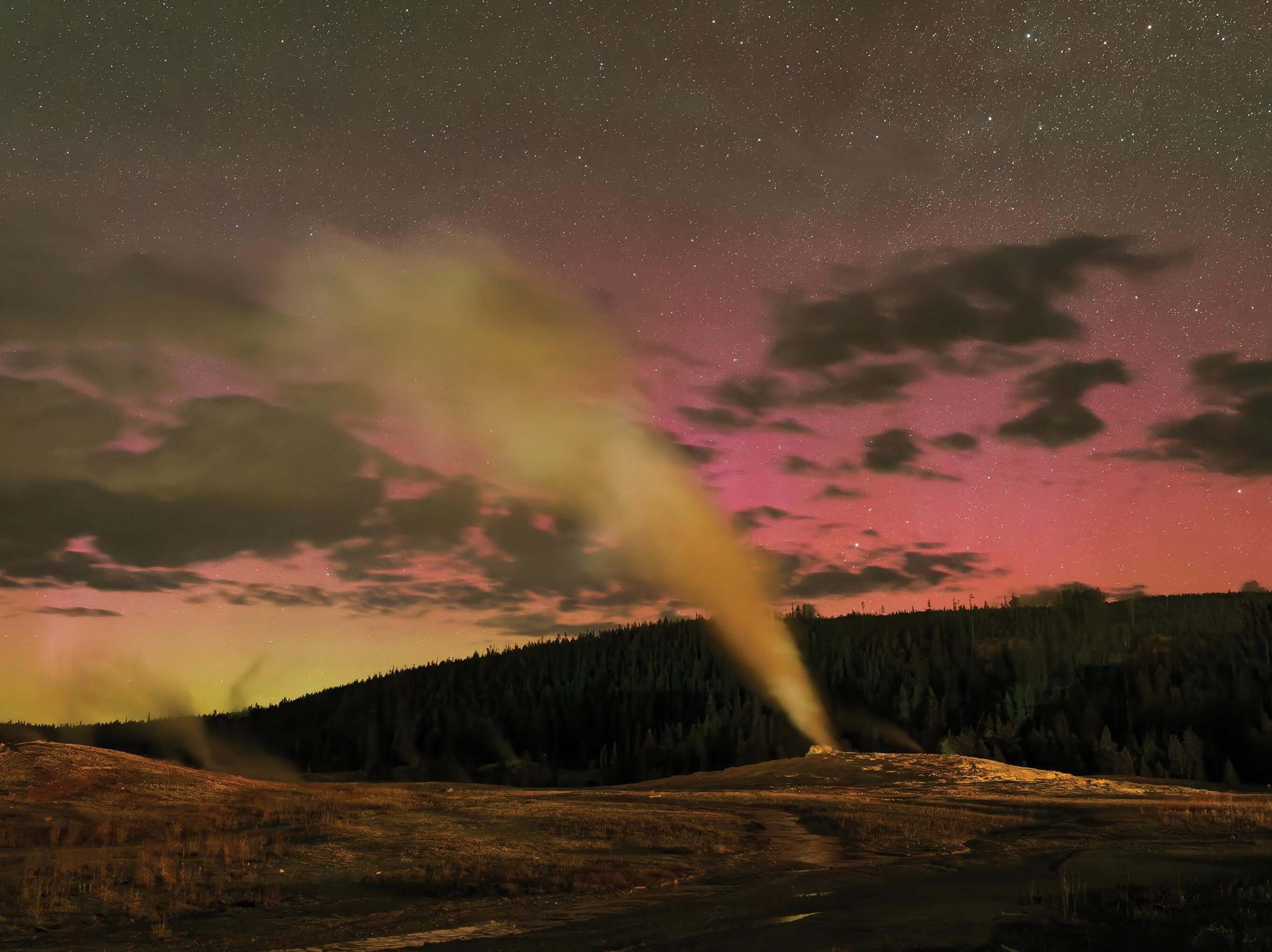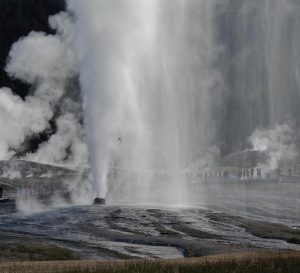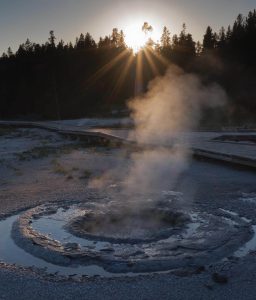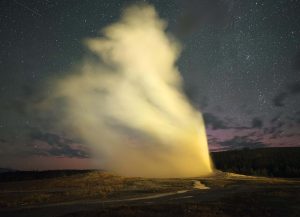
30 May Images of the West: The Right Time and Place
As the blue light of dusk faded to an obsidian black, I gathered my gear. Upon opening the door of my camper van and stepping into the night, coyotes broke the silence and began to sing — or so it’s described by numerous Western authors. I never felt the sound of coyotes was all that melodic. Add their screechy yips to a pitch-dark hike in Yellowstone National Park, and it’s easy to see why the hair on the back of my neck stood on end.

Beehive Geyser in Yellowstone National Park erupts just before the sun begins to set.
My headlamp pierced the dark, lighting the paved walkway to Castle Geyser. I was on a mission to capture the northern lights dancing above the billowing steam. I chose Castle because it wasn’t all that far of a hike, and the trail ran alongside its southern edge. Setting up on the pathway, looking toward the geyser, I was sure to be pointed north.
All the science was in place to have a spectacular showing. NASA has found that northern lights are dependent on “magnetic storms that have been triggered by solar activity, such as solar flares (explosions on the sun) or coronal mass ejections (ejected gas bubbles).” Solar storms are known to blast those charged particles into space, where they eventually find their way into the Earth’s atmosphere. It’s hard to believe, but science’s beauty is the ability to unravel the unknown. Equally beautiful is the appearance of streams of reddish or greenish light in the sky — northern lights or aurora borealis.
Four days earlier, I had heard on national news that a solar storm was en route from the sun. Wednesday was supposed to be the day it collided with Earth’s atmosphere and, thus, the day the show would begin. The Geophysical Institute of the University of Alaska Fairbanks’ aurora prediction website confirmed what I heard on the news. The solar storm was so intense that the auroras’ visibility was predicted in the Northern U.S., an event not overly common. I’ve done most of my aurora photography in Alaska and northern Canada, so thinking there might be a chance to see them close to my home in Bozeman, Montana was beyond exciting.

An unidentified hot spring gives off steam as the sun drops in the Western sky.
I looked toward the north as I made my way down the trail to Castle Geyser. When I got to the geyser, the darkness was dense. My watch read 10:30 p.m. as I set my tripod up and waited. The clock ticked by as Castle Geyser continued to do what it’s been doing for 15,000 years. No significant eruptions took place, but a constant plume of steam kept rising from its cone: one hour, two hours, three hours, then four. Eventually, I had to give in, and at 2:30 a.m., I returned to my van. No northern lights tonight.
The next night came along, and I decided to change my plans. Previously, I had watched from afar as Old Faithful erupted in the beautiful warm glow of lights from the lodge. Since it was after the predicted peak of the solar storm, there wasn’t much chance for auroras, so I concentrated on Old Faithful and its starry sky backdrop.
I set up in front of the visitor’s center. Old Faithful kept to her regular schedule, giving me several opportunities to capture her portrait against the night sky. When I reviewed my pictures on the back of my camera, I was frustrated by the colored lights I saw on the horizon. I cursed Gardiner, Montana, the only explainable source of such remote light pollution. After two eruptions, and at about 2:30 a.m., I had an epiphany. The lights I saw were red and green. These weren’t from light pollution; these were the northern lights.

Initially mistaken for light pollution, the subtle magenta hue of the northern lights shines just above the horizon behind Old Faithful.
It sounds unbelievable that I had gone to the park to shoot the northern lights, and when they appeared, I had no idea what I was looking at. By way of explanation, you should know that I could not see them with my naked eye. I have found that often the auroras can only be seen with digital capture. Additionally, they were on the horizon. I’ve only seen auroras on the horizon once, when I photographed them over Lake Superior near my boyhood home in Minnesota. All other northern light experiences have taught me to look virtually straight up in the sky. That’s where they typically appear in the Alaskan and Canadian Arctic. But, here in the Northern U.S., they appear on the northern horizon.
All in all, it was a great shoot. Seeing two of the world’s most exciting natural phenomena and capturing both in the same frame was its own reward; the images were as priceless as the experience.
Daniel J. Cox has been documenting the world of nature and conservation for four decades. His publications include two National Geographic cover stories, hundreds of magazine covers, and a dozen books. In 2013, he was awarded the North American Nature Photographer Association’s (NANPA) Outstanding Photographer of the Year. In 2023, he received NANPA’s Environmental Impact Award for his Arctic Documentary Project for Polar Bears International. When not on assignment, Cox teaches photography via his company, Natural Exposures Invitational Photo Tours, with his wife, Tanya; naturalexposures.com, @danieljcoxne.




Ted Barber
Posted at 01:21h, 01 AugustTHESE PHOTO ARE AWESOME AND THANK YOU FOR SHARING.